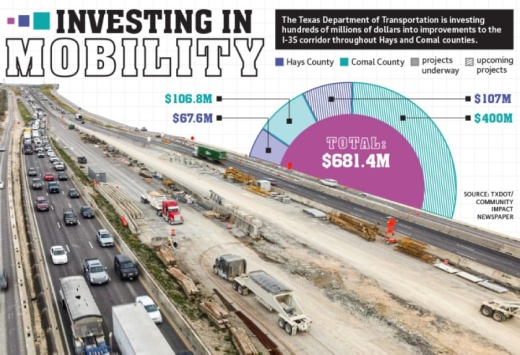Adams has to traverse heavy construction along I-35 daily, and he said he feels the drive has become more dangerous, and he sees car accidents all the time, especially in the zones involving construction.
“Specifically, right on the north side of New Braunfels ... they diverted traffic to either side of construction going south and north,” he said. “You’ll get in positions where truck drivers will pass each other, and you’ll get stuck either slamming on the brakes or speeding up to get through it.”
Though Adams said he feels his commute was easier before all of the construction began in Comal and Hays counties, state and local officials maintain that rapid growth combined with frequently jammed traffic throughout Central Texas has necessitated substantial upgrades to I-35.
An ongoing effort to improve mobility on I-35 is seeing about $68 million in current construction costs with another $107 million to come for projects in Hays County, and in Comal County $107 million in construction is in progress with another $400 million to come.
As work to create overpasses, update frontage roads, incorporate pedestrian infrastructure and increase overall mobility and safety continues, project leaders at the Texas Department of Transportation, as well as city engineers throughout the area say the massive investment will benefit all motorists—from those who make long commutes daily to those who need to get through their own towns more quickly.
Projects underway
Throughout the stretch of I-35 that runs from the south Comal County line to the north Hays County line, there are six projects currently under construction that combine for a total price tag of approximately $175 million.
Although Travis County is often seen as the locale of the largest projects with regard to the Central Texas portion of the I-35 overhaul, Susan Fraser, a program manager for the Mobility35 project that includes Williamson, Travis and Hays counties said Hays County is an important piece of the overall upgrade.
“It’s never been just a route from Austin to San Antonio,” she said. “It’s the second [fastest] growing county in the nation. It’s got the fourth largest university. It’s got the retail space, [including] the outlet mall. Buda and Kyle are growing.”
Fraser said that justifies the total $440 million estimated construction cost for completed, current and planned projects on I-35 in Hays County alone.
Ongoing projects in Hays County include improvements on I-35 from RM 150 to Kyle Crossing, Posey Road and Loop 82 to River Ridge Parkway.
In Comal County, three projects totalling roughly $106.8 million in construction costs are ongoing. From north to south, those are the FM 306 to Hays County line, Guadalupe River to FM 306 and FM 2252 to Schwab Road projects.
TxDOT Engineer Will Locket said those three projects are classified as operational improvement projects that primarily involve intersection improvements and some ramp reversals.
The FM 2252 to Schwab Road project will include a Park and Ride station and will primarily focus on ramps and the frontage roads, the FM 306 project will focus on that road’s intersection with I-35, and the FM 306 to Hays County line project will add an overpass and update the frontage road throughout the length of construction.
“The three projects going on right now in Comal County will help ... with the merging points on I-35, and free up some of that congestion as people try to exit and enter the freeway,” Locket said.
Upcoming projects
In the next five to 10 years, TxDOT will be working on a roughly 20-mile portion of I-35 from I-410 in San Antonio up to FM 1103 in Comal County.
Called the I-35 Northeast Expansion, or NEX, its main feature will be an elevated bridge along the freeway that will provide entrances and exits every three miles or so, according to TxDOT Engineer Daniel Worden.
Dating back to its initial planning stages in 2013, The NEX project is estimated to cost $3 billion and will be completed in three phases.
The Central Phase, for which construction is scheduled to begin in early 2022, will run from FM 3009 to the I-410 North interchange and cost about $1.6 billion,
The south phase is scheduled to go out for contract in April 2023, will go from the I-410 North interchange and end at the I-410 South interchange and cost an estimated $1 billion.
The North Phase will come last, run from FM 3009 to FM 1103 in the south end of Comal County and will cost roughly $400 million.
“It’s for mobility. It’s not for access to local businesses,” Worden said. “It’s basically to get folks in from the outlying communities—New Braunfels, Comal County—get them into downtown [San Antonio] and vice versa.”
Worden said the North Phase of the NEX project is still unfunded and likely won’t go out for contract until fall 2025, and it will involve the reversal of ramps and freeway reconstruction.
“It’s intended for regional travel,” he said. “We’re looking at taking about 30% of the existing traffic that is on the existing main lanes and putting that up onto the elevated lanes. [Drivers] will basically be able to get to Comal County from San Antonio uninterrupted.”
In Hays County starting at the end of 2021, TxDOT is slated to begin construction on a section of I-35 south of San Marcos that will reconstruct and improve its intersection with SH 123.
Among other work, the estimated $107 million project will reverse two ramps along the northbound frontage road between SH 80 and SH 123, reconstruct portions of the northbound and southbound frontage roads and add pedestrian and bicycle accommodations.
Fraser said the project will go out for bids in April, and even though TxDOT’s website states it is scheduled for completion by the end of 2023, a more realistic timeline projects completion some time in 2024, or possibly 2025.
“This is really going to help with the bottlenecks from some of the traffic backups that we’ve been seeing on the main lanes and the frontage roads,” Fraser said. “A lot of good work went into this project, and we’re excited it’s about to kick off.”
Other benefits of the I-35 upgrades
Laurie Moyer, director of engineering and capital improvements for the city of San Marcos, said that beyond the direct benefits associated with upgrading I-35, the city stands to benefit in other ways.
“One of the big things that we’re all seeing is just the growth between the Austin and San Antonio corridor,” Moyer said. “What has really rung true to me is that based upon the population projections within the next 20 years, we’re going to have a population between that Austin/San Antonio corridor to match Dallas/Fort Worth.”
In terms of transportation, Moyer said I-35 improvements are just one piece of the puzzle when determining how to accommodate that growing population.
Moyer also pointed to a study conducted by the Capitol Area Metropolitan Planning Organization stating that not only is I-35 in Central Texas used for long-distance travel, a large percentage of motorists use it for crosstown travel in their own cities.
Therefore, she said not only will the upgrades improve regional travel, they will help drivers navigate local commutes.
In Comal County, New Braunfels Public Works Director Greg Malatek said the local I-35 improvements are critical to help ease traffic, and also mentioned the rapid growth the area continues to experience.
Maletek said all of the continuing population growth is leading to more new commercial and residential developments.
With that in mind, some of the local work on I-35, including for the FM 306 to Hays County line project, is going to end up benefiting new development coming to the area.
Maletek said that in conjunction with the I-35 improvements, improvements to roads and infrastructure in and around New Braunfels will help open up travel routes for thoroughfares both large and small.
“All of the work that our city is doing through our bond initiatives on streets and roadways, this is just additional pieces of the puzzle,” he said. “The I-35 projects, they’re needed, and they’re just a part of our process to upgrade the city.”
As projects continue in Hays and Comal counties throughout the next decade, Moyer said it will remain critical for city engineering staff such as herself to continue working with TxDOT to make sure peripheral roads projects don’t cause more disruption than is already occurring with such a major overhaul.
One example includes improvements to the infrastructure in the Blanco Garden subdivision, which is between Hwy. 80 and the San Marcos River on the east side of I-35.
Moyer said preparations for that project are underway, and it is important to make sure residents can safely enter and exit the neighborhood, especially since work on I-35 continues.
“We’ve got to pay attention to, ‘Can our citizens still move back and forth across I-35? Are we going to be doing projects that are going to hurt other streets that may be used in lieu of I-35?’” Moyer said. “So, that’s what we’re trying to do.”





